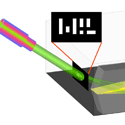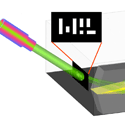What lies beneath
Carpet cloaks hide an object under a smooth bump that appears flat to the observer—at least over a range of wavelengths of light. In order to distort light so as to hide an object, a carpet cloak must be made out of an anisotropic material. So far, scientists have focused on using metamaterials—artificial structures built out of subwavelength elements—to construct such cloaks, but these designs rely on expensive nano- or microfibrication, have so far been limited to infrared wavelengths or longer, and aren’t practical for hiding objects more than a millimeter in size.
Now, Baile Zhang and colleagues at the Singapore-MIT Alliance for Research and Technology Center announce in a paper appearing in Physical Review Letters that they have fabricated a carpet cloak that hides macroscopic objects over a broad range of visible wavelengths. They make their carpet cloak out of calcite—a naturally anisotropic material—split into two crystallographic blocks with different orientation of their respective principal refractive indices. They place the cloak over a steel wedge, 2mm high and 38mm wide, which sits on a mirror, and illuminate it with a beam of green polarized light. As evidence that the cloak hides the wedge, they see the reflection of the beam from only the underlying mirror.
Although Zhang et al.’s calcite cloak currently only works with polarized light and for a specific geometry, it is inexpensive, absorbs little light, and could ultimately hide larger objects. – Manolis Antonoyiannakis





